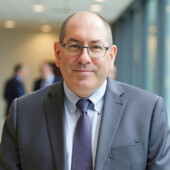00:00:00.000 --> 00:00:06.000
[Speaker: Dr. Tony Vine.]
[Visual: Dr. Vine in his medical office speaking to the camera.]
[Music: Soft, inspirational music begins.]
Hi, I'm Dr. Tony Vine. I'm a laparoscopic
surgeon, so I do minimally invasive surgery,
00:00:06.000 --> 00:00:13.000
[Visual: Illustration of the digestive tract.]
involving the intestinal tract all the way
from the esophagus down to the anus.
00:00:13.000 --> 00:00:22.000
[Visual: Dr. Vine walking through the hallway of his
medical practice and into his office.]
How I came to medicine was really through my father.
I asked him if he wanted me to take over his dental practice.
00:00:22.000 --> 00:00:30.000
[Visual: Photo of Dr. Vine smiling with his elderly father.]
And he said to me, “For the four years that you go to dental school,
you may as well go to medical school and learn the whole thing.”
00:00:30.000 --> 00:00:38.000
[Visual: Photo of Dr. Vine standing wearing blue scrubs.
Then, Dr. Vine speaking to the camera.]
I have been practicing medicine for approximately
30 years.
00:00:38.000 --> 00:00:47.000
[Visual: Photo of Dr. Vine with former classmates
at Vanderbilt Medical School.]
I graduated from Vanderbilt Medical School in 1989, and started
at Mount Sinai for my residency in that same year…
00:00:47.000 --> 00:00:54.000
[Visual: Back to Dr. Vine speaking directly to
the camera]
…and did two years of research in the middle of
my residency at Massachusetts General Hospital.
00:00:54.000 --> 00:01:03.000
[Visual: Mount Sinai graduation photo of
Dr. Vine with classmates and professors.]
Came back to Sinai in 1994 and graduated
as a chief resident from there in 1996…
00:01:03.000 --> 00:01:10.000
[Visual: Photo of Dr. Vine performing surgery in blue scrubs.]
…and immediately started work in July of 1996.
00:01:10.000 --> 00:01:16.000
[Visual: Dr. Vine, smiling and speaking to the
camera, then a photo of Dr. Vine playing violin in green scrubs.]
In my spare time,
whatever little there may be of it,
you can find me practicing my violin.
00:01:16.000 --> 00:01:24.000
[Visual: Video of Dr. Vine at desk.]
[Visual: Then, photos of Dr. Vine with NY State Senators.]
You might find me preparing for a meeting
with a New York State Senator for lobby day.
00:01:24.000 --> 00:01:29.000
[Visual: Photo of Dr. Vine with one of
his chief residents.]
You might find me teaching the
medical students and residents.
00:01:29.000 --> 00:01:34.000
[Visual: Photo of Dr. Vine with a chief resident.]
I think that my humanistic background,
having been an English major in college,
00:01:34.000 --> 00:01:44.000
[Visual: Video of Dr. Vine playing with the orchestra.
Music: Background music fades out.
Sound of Dr. Vine playing the violin begins.]
being a violinist, I feel that I come to medicine
with more of a humanistic, compassionate approach.
00:01:44.000 --> 00:01:49.000
[Visual: Dr. Vine speaking to camera.
Music: Violin music fades out.
Original background music resumes softly.]
I really try and treat my patients as if they were my family members.
00:01:49.000 --> 00:01:54.000
[Visual: Fade to black.
Music fades out.]
Esophageal Diverticulum
What Is An Esophageal Diverticula?
An esophageal diverticulum is a pouch that forms in the esophagus, protruding through a weak area in the esophageal lining or wall. This outpouching traps food and liquids and can lead to difficulty swallowing and other issues.
Types of Esophageal Diverticula
- Zenker’s Diverticulum – develops near the throat, in the upper part of the esophagus
- Mid-Esophageal Diverticulum – forms in the middle of the esophagus, often caused by scarring or inflammation
- Epiphrenic Diverticulum – found close to the stomach, near the lower esophagus
Esophageal Diverticulum Symptoms
- Difficulty swallowing
- Regurgitation of undigested food
- Coughing or choking, especially at night and when lying down
- Sensation of food stuck in the throat or chest
- Bad breath
What Causes an Esophageal Diverticulum?
According to Dr. Anthony Vine, esophageal diverticula may be caused by high LES pressures or previous GERD surgery where the wrap has been made too tight. The diverticulum almost always projects into the right chest on radiographic evaluation and may be confused for a hiatal hernia.
Treatment Options for Achalasia and Esophageal Diverticula
Dr. Vine has had enormous success performing laparoscopic surgery on patients with large or symptomatic esophageal diverticula with intraoperative assistance from a gastroenterologist using an endoscope. A team approach always yields the best results.
He sees patients for consultations at the Laparoscopic Surgical Center of New York located at 1010 5th Avenue in New York City.
For more on the minimally invasive surgical options visit our Laparoscopic Esophageal Surgery and Heller Myotomy page.

